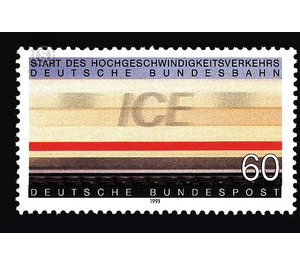Start of the ICE traffic of the German Federal Railways - Germany / Federal Republic of Germany 1991 - 60 Pfennig
Theme: Post & Philately
| Country | Germany / Federal Republic of Germany |
| Issue Date | 1991 |
| Face Value | 60.00 |
| Color | multi-colored |
| Perforation | K 14 |
| Printing Type | 4-color offset printing |
| Stamp Type | Postage stamp |
| Item Type | Stamp |
| Chronological Issue Number | 1403 |
| Chronological Chapter | GER-BRD |
| SID | 58381 |
| In 41 Wishlists | |
On 2 June 1991 the high-speed traffic of the German Federal Railways starts: The new InterCityExpress is used starting from this day on schedule, and the two new routes Hanover-Würzburg and Mannheim-Stuttgart go into enterprise. After the introduction of the InterCity trains in regular traffic in the winter of 1971/72, this is another milestone on the way to a contemporary railway. With comprehensive network modernization and the use of a powerful new vehicle, Deutsche Bahn is setting the course for its future. It can eliminate serious bottlenecks and many shortcomings while at the same time creating the conditions for forward-looking high-speed traffic. The plans include the construction and construction of a total of 4000 km of railway lines until the turn of the century. Half of these routes are designed for speeds of 100 to 250 or 300 km / h. With the billions in investments in the route construction and in the vehicle procurement the railway receives the chance to make good ground lost against the other traffic carriers. On the way on a railway network, which for the most part dates from the previous century, she seemed to have already lost the connection. However, thanks to increased environmental awareness, the advantages of the railway are now becoming increasingly important. Nobody today seriously denies the environmental benefits of modern rail transport. The trump cards of the railway are obvious: no other means of transport is so clean, so economical and at the same time so safe. The right vehicle for the fast routes is the InterCityExpress, short ICE. With this new train generation, Deutsche Bahn is responding to the increased customer demands for more speed and more comfort. »ICE - the new dimension of travel« is not just a slogan, but a reality: the top offer of the Deutsche Bahn sets standards for contemporary travel. After implementing all the measures provided for in the Federal Transport Infrastructure Plan, the ICE connects Munich and Cologne in four instead of the current six hours, and travel time between Stuttgart and Hamburg will shrink from around seven to five hours in the future. Also in terms of comfort, the ICE offers the traveler significantly more. In the future, every single car will have the possibility of choosing between different seating arrangements: There are both compartment seats and open-plan seats in rows and vis-à-vis arrangements. The color-coordinated interior creates an elegant atmosphere of functional objectivity and makes the journey an experience. The communication facilities in the ICE go with the times: Telephone is available in the first and in the second class. Completely new is the computer-assisted passenger information system, which informs the travelers partly fully automatic, partly via input by the train crew with all information directly related to the journey. For example, passengers receive information about the next station and connections via this facility. Furthermore, the seats are equipped with audiovisual facilities. In the future, you will be able to hear three radio programs and up to three on-board music programs in all seats. In addition, a cordless telephone and a fax machine are available in an office compartment. The inauguration of the two new lines and the launch of the InterCityExpress are the prelude to the rapid expansion of German rail transport. This also benefits fast freight traffic with speeds of up to 160 km / h. Numerous other measures are already under construction or are in the planning phase. At present the investigations for the development of fast railroad connections for the whole German traffic area run. High-speed traffic has meanwhile also reached a European dimension: cross-border connections will become more and more important in the future. Due to its central location, German rail traffic will play an important role. (Text: German Bundeshahn, Press and Public Relations, Frankfurt am Main)


